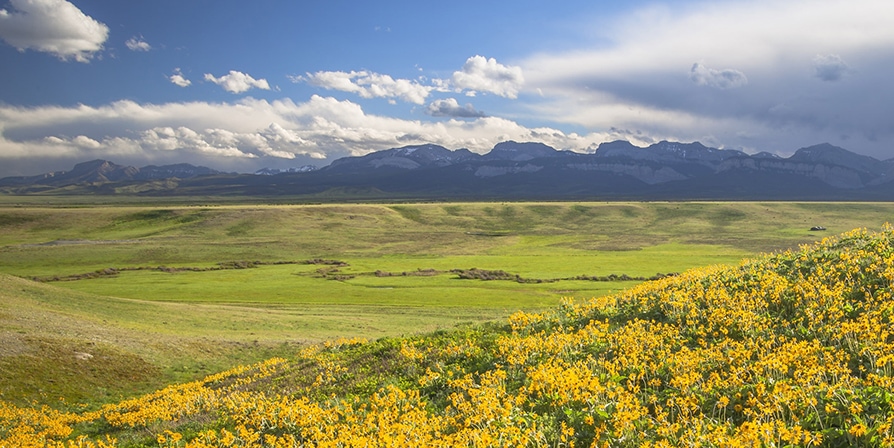Investing In And Adding Value To Ranch Lands
By Clarke Watson
The Western U.S. has a reputation for landscapes that are rich in rivers, mountains, and open space. But the American West is losing large chunks of land as landscapes are carved away to accommodate the urban sprawl and commercial development that affects many western cities. According to a study by the Center for American Progress, between 2001 and 2011, natural areas in the West—including forests, wetlands, deserts, and grasslands—were disappearing at the rate of one football field every 2.5 minutes. During that 10-year span, the footprints of towns and cities throughout the U.S. grew by nearly 17 percent, and approximately 4,300 square miles of natural landscape were lost to development, an area larger than Yellowstone National Park.
With the habitat around us diminishing, private landowners have grown increasingly aware of the role they can play as conservationists and the resulting investment value of this approach. As many savvy land investors know, improving natural and agricultural landscapes has the added benefit of increasing the land’s overall value.
Everyone engages with land differently, but the allure of a rural lifestyle, privacy, open space, and direct access to wilderness and wildlife habitats beckons many high-net-worth individuals to diversify their investment portfolios by acquiring land. By being good stewards, these individuals can benefit from a diverse, productive piece of property to supplement the year-over-year increase in value.
LAND AS A STABLE INVESTMENT
A native Oregonian, Jerry Hicks has been with Fay Ranches for 16 years, offering clients a combination of land management and land transaction expertise. “Land is an asset that gives investors an opportunity to safely and steadily boost and diversify returns over time,” Hicks explains. “Unlike stocks, bonds, or other commodities where investors can dive in and out of the market, ranchland is a steady-as-you-go investment that is ideal for anyone looking to put money toward something tangible. Land investors, for the most part, are in a solid financial position which contributes to the stability of the land market.”
Bill Nugent has purchased several properties from Hicks and has made a living buying and selling ranches throughout the country with an emphasis on raising cattle for beef production. Nugent has a hands-on approach to his method of investing. “I might look at 20 to 30 ranches and farms before I make a purchase, and I scrutinize them based on what needs to be done to make it work for cattle, hay, or whatever the ranch may produce.”
His business plan has been effective, which has enabled Nugent to buy, improve and eventually sell his properties for profit. “It’s a great business plan if you don’t mind putting in the work. I’ll sell a ranch, and I’ll get paid for my efforts.”
From an estate planning and tax perspective, Hicks finds 1031 Tax Deferred Exchanges to be a great tool. “Many clients step into a property utilizing a 1031 Tax Deferred Exchange. They may want to put cash somewhere, or they need to postpone or defer capital gain. A ranch gives them the opportunity to defer those gains as long as they need to,” Hicks says. “Another benefit is that landowners immediately start a depreciation schedule on their properties to help with taxes, all the while the property value increases over time.”
LAND STEWARDSHIP — ADDING VALUE TO YOUR PROPERTY
There are also land stewardship strategies that landowners can implement to add value to an investment. Stewardship, aside from being neighborly, adds to the land’s recreational qualities, which translates to an increase in the land’s overall value. “Improving ranches has always been a passion for us,” says Greg Fay, Founder of Fay Ranches. “When I got into land brokerage more than 25 years ago and started Fay Fly Fishing Properties, we were the first company in the Rockies to assign value to recreational attributes. We were at the forefront, talking about the marriage of agriculture and recreation as mutual beneficiaries.” Fay explains that they’ve done everything from constructing houses and improving agricultural operations to building sporting clay courses and enhancing fisheries and wildlife habitats. “Through that process, we learned a lot about which land improvements provided the best return for our clients and increased the value of their properties,” he adds. There are many land steward strategies. Something as simple as rotational grazing for cattle can pay huge dividends for both the agricultural and recreational capacities of a property.
“Sustainable land management doesn’t always mean you need to cut back on the size of your herd,” says Fay. “It means you need to be more hands-on with grazing tactics and in-tune with how the animals are interacting with the land.”

WATER, WATER EVERYWHERE
Although there are many tactics to improve the integrity of a landscape, not all are created equal. “When I look at improving ranches and creating value, water is more significant than any other resource,” Fay explains. “In terms of impact, building ponds, wetlands, and moving-water fisheries are probably the most significant land improvement from a dollar standpoint.”
Bryan Pickens, a Dallas-based Partner/Broker with Republic Ranches, agrees. “From the perspective of a buyer looking to invest in a ranch, they have a checklist prioritizing attributes they’d like to see,” Pickens says. “Water is almost always at the top of this list. If you have a great live-water fishery or ponds and lakes to toss a line into, it adds another dimension of recreation to a property.”
INVEST IN NATURE, CONNECT WITH NATURE
Fay and Republic clients come from diverse backgrounds, but most share a common trait: an enduring appreciation for natural settings. “The folks represent affluent, high-net-worth individuals,” explains Pickens. “They share a passion for buying land and taking ownership.”
Many clients want to improve landscapes for their children, their grandchildren, and future generations, and it’s a process. “You must take the long approach and be patient,” Pickens says. “With patience comes results. These results include re-establishing native grasslands, healthy watersheds, and an increase in wildlife.
In the end, all of this adds to the aesthetics and bottom line of your property.”

Discover the Charm and Opportunities of North Dakota
Are you considering a move but unsure where to settle? North Dakota, often overlooked by travelers and potential residents alike, offers a wealth of opportunities and a lifestyle to suit a variety of preferences. Whether you’re drawn to outdoor adventures, a slower pace of life, or expanding career opportunities, this charming state has something to […]

Easement Dispute – Ask an Agent
Dear Land Expert, I am preparing to list my Western ranch soon; however, my neighbor is currently contesting an easement that crosses a corner of their property, an access route I’ve used consistently and that has been essential for reaching certain parts of my land. While I’ve always understood this to be a valid easement, […]



